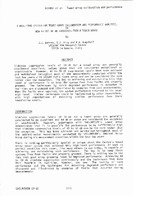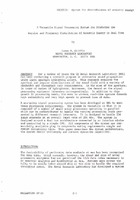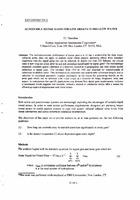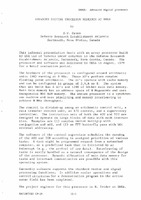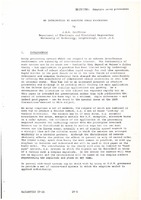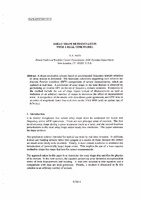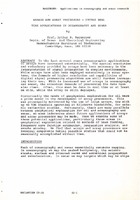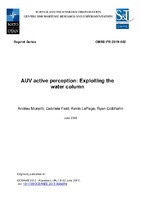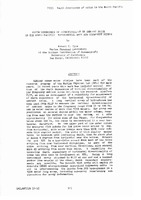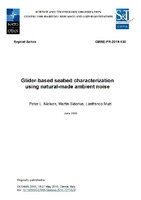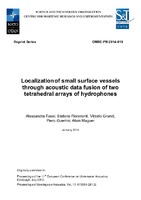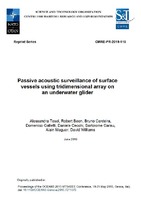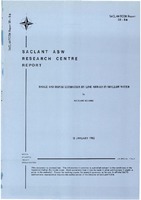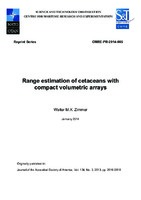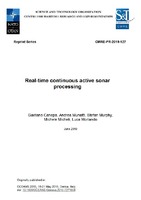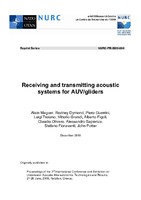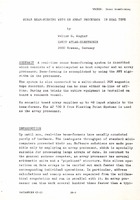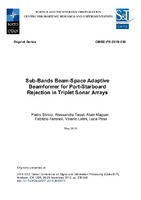Browsing Reprints by Subject "Sonar arrays"
Now showing items 1-20 of 25
-
A real time system for towed array calibration and performance analysis, or how to get 50 dB sidelobes from a towed array
(NATO. SACLANTCEN, 1982/06)Sidelobe suppression levels of 30 dB for a towed array are generally considered excellent; values above that are considered exceptional or unachievable. However, 40 t o 50 dB suppression levels have been achieved and ... -
A versatile signal-processing system for producing the angular and frequency distribution of acoustic energy in real time
(NATO. SACLANTCEN, 1979/12)For a number of years the US Naval Research Laboratory (NRL) has been conducting a research program in underwater sound propagation using large aperture hydrophone arrays. This research requires the spectral and angular ... -
Achievable signal gains for line arrays in shallow water
(NATO. SACLANTCEN, 1993/08)The well-documented conformance of signal gain to a 20 log n relationship for deep water, refracted paths, does not apply to shallow water where angular spreading effects from boundary roughness limit the signal gains that ... -
Advanced digital processor research at DREA
(NATO. SACLANTCEN, 1979/12)This informal presentation deals with an array processor built by ESE Ltd of Toronto under contract to the Defense Research Establishment Atlantic, Dartmouth, Nova Scotia, Canada. The processor and software was delivered ... -
An introduction to adaptive array processing
(NATO. SACLANTCEN, 1979/12)Array processing systems which can respond to an unknown interference environment are currently of considerable interest. The fundamentals of such systems are by no means new - basically they depend on Weiner's filter ... -
Array and cable tracking data through ship maneuvers
(NATO. SACLANTCEN, 1993/08)This paper presents tracking results from two sea tests in which a towed cable and array were tracked at the Atlantic Undersea Test and Evaluation Center (AUTEC). The tracking tests involved instrumenting the cable with ... -
Array shape determination with a real-time model
(NATO. SACLANTCEN, 1993/08)A shape estimation scheme based on precomputed frequency-domain solutions of array motion is presented. The boundary conditions supporting each solution are discrete Fourier transform (OFT) components of sensor measurements, ... -
Arrays and array processors: future real time applications in oceanography and sonar
(NATO. SACLANTCEN, 1979/12)In the last several years oceanographic applications of arrays have increased substantially. The spatial resolution and redundancy provided by arrays have been necessary in the interpretation of signal propagation in complex ... -
AUV active perception: exploiting the water column
(CMRE, 2019/06)Autonomous Underwater Vehicles (AUVs) present a low-cost alternative or supplement to existing underwater surveillance networks. The NATO STO Centre for Maritime Research and Experimentation is developing collaborative ... -
Depth dependence of directionality of ambient noise in the North Pacific: experimental data and equipment design
(NATO. SACLANTCEN, 1982/06)Ambient ocean noise studies have been part of the research program of the Marine Physical Lab (MPL) for many years. In recent years this work has included several studies of the depth dependence of vertical directionality ... -
Glider-based seabed characterization using natural-made ambient noise
(CMRE, 2019/06)Seabed characteristics (geoacoustic properties and scattering strength) are critical parameters for sonar performance predictions. However, this bottom information is considered very difficult and expensive to achieve in ... -
Glider-based seabed characterization using natural-made ambient noise
(CMRE, 2019/06)Seabed characteristics (geoacoustic properties and scattering strength) are critical parameters for sonar performance predictions. However, this bottom information is considered very difficult and expensive to achieve in ... -
Localization of small surface vessels through acoustic data fusion of two tetrahedral arrays of hydrophones
(CMRE, 2014/01)Detection and tracking of vessels is important in confined areas such as marine parks or harbors. Nowadays, the presence of ships can be accurately monitored either by radar or via AIS system, while small vessels, which ... -
Passive acoustic surveillance of surface vessels using tridimensional array on an underwater glider
(CMRE, 2019/06)The NATO-STO Centre for Maritime Research and Experimentation (CMRE) has proposed to approach the problem of monitoring marine traffic in defined sea areas by using passive acoustics on a mobile underwater platform, in ... -
Range and depth estimation by line arrays in shallow water
(NATO. SACLANTCEN, 1982/01)In shallow water sound propagates in terms of normal modes. The interference between the modes can be utilized to estimate range and depth of an acoustic source in shallow water by applying high resolution power estimators ... -
Range estimation of cetaceans with compact volumetric arrays
(CMRE, 2014/01)Passive acoustic monitoring is the method of choice to detect whales and dolphins that are acoustically active and to monitor their underwater behaviour. The NATO Science and Technology Organization Centre for Maritime ... -
Real-time continuous active sonar processing
(CMRE, 2019/06)This work describes the development of continuous active sonar (CAS) processing at CMRE. The software uses subband processing to achieve a faster update rate than is possible with pulsed active sonar (PAS). The software ... -
Receiving and transmitting acoustic systems for AUV/gliders
(NURC, 2009/12)NURC in the past years have focused its research on the use of AUV and more recently on gliders and is now developing littoral autonomous sensing networks based onthose sensors to perform missions such as mine warfare, ... -
Sonar beam-forming with an array processor in real time
(NATO. SACLANTCEN, 1979/12)A real-time sonar beam-forming system is described which consists of a minicomputer as host computer and an array processor. Beam-forming is accomplished by using the FFT algorithm in the processor. The system is also ... -
Sub-bands beam-space adaptive beamformer for port-starboard rejection in triplet sonar arrays
(CMRE, 2019/05)This paper addresses the problem of Port-Starboard (PS) beamforming for low-frequency active sonar (LFAS) with a triplet receiver array. The paper presents a new algorithm for sub-bands beam-space adaptive beamforming with ...
